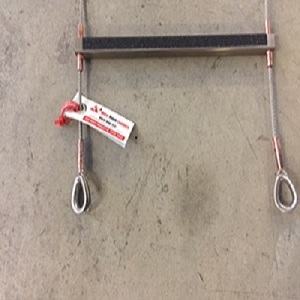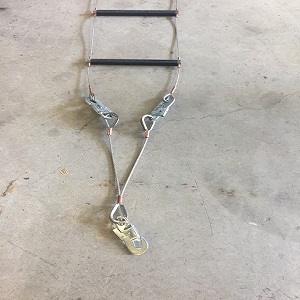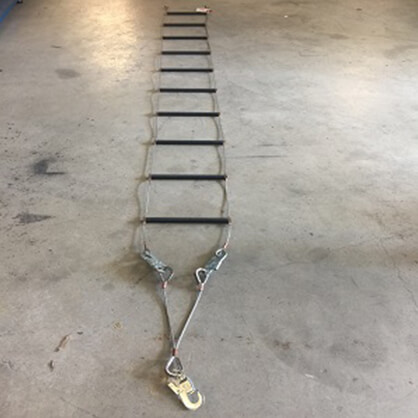100% Safety tested
Wire Rope Ladders
made right here in Australia
Secure Ascent: Crafted Wire Rope Ladders, Rigorously Tested in Australia
See our range of safety load-tested Wire Rope Ladders used by safety specialists throughout Australia and worldwide. Our ladders are used by emergency services, tree felling, caving and the rock climbing community. We make all of our ladders right here in Australia and distribute throughout the world. Give us a call today to discuss your requirements by speaking with our Director David Sullivan.
Wire Rope Ladders Customers











Flexibility
The ladders have rigid rungs (Aluminium and Stainless steel) and flexible sides that are made from wire rope. The advantage of this is that it allows the ladders to be suspended from a fixed point rather than like a conventional ladder. Our ladders can be rolled up for easy transport and storage, weigh much less than a conventional ladder, and can be deployed in confined spaces.

Wire Rope Ladders: Precision Crafted for Safety and Efficiency in Demanding Environments
Our Wire Rope Ladders are trusted by professionals worldwide
Wire Rope Ladders
- The above ladder has a stand-off attached which makes climbing easier. (This can be specially ordered for all ladders).
- Wire Rope Ladders are more flame resistant than materials such as wood.
- We have standard stock sizes (6m, 9m, 15m, 20m, 25m, 30m) in aluminium and stainless steel.
- These standard sizes come in both light weight and medium weight wire rope ladders.
- If the standard stock sizes do not fit, we can custom make any size to suit your application.
Custom Made Wire Rope Ladders
Download the Wire Rope Ladders catalogue
Inside you’ll find a heap of useful information
Non-Slip Finished Applied To Rung
All Stainless Steel ladders have a SWL of 200kg per rung. All Aluminium ladders have a SWL of 130kg per rung. They have a tag with serial number, manufacturer’s identification, date of manufacture, and safety maintenance check.20

Anti Slip Tag

Ladder With Non-Slip

S/S Ladder with Non-Slip Finish on each rung. with S/S trace using 6mm wire and Gal snap hooks
Rubber Standoffs
Rubber standoffs are designed to be used on wire rope ladders to keep the ladder off the structure being climbed.
These standoffs are designed to wrap around the wire rope and create a separation between the ladder and the surface, preventing the ladder from rubbing against or damaging the structure. The rubber material provides a non-slip surface, which helps to keep the ladder stable and secure, reducing the risk of accidents or injuries. The rubber standoffs can provide increased grip and traction, helping to prevent slips and falls.
Additionally, the standoffs can help to distribute the weight of the ladder more evenly, reducing the pressure on any particular point of the structure being climbed. This can be particularly important when climbing delicate or fragile surfaces that require extra care and attention. The use of rubber standoffs for Wire Rope Ladders not only protects the structure being climbed but also enhances the safety and stability of the ladder, making it a more reliable tool for various climbing applications.
Rubber is a durable and long-lasting material, which means that the standoffs are resistant to corrosion and other forms of damage.

A Guide to the Care and Use of Your
Wire Rope Ladder
- Normally the life of wire rope will depend upon the amount of bending it receives. Bending can be minimised by the following :
- If a large anchorage (belay point) causes the ends to diverge excessively an extra trace could be used or a karabiner linked across the “C” clips.
- The rungs should be horizontal – not tilted.
- If the wires between adjacent rungs tend to form a helix, the ladder has probably passed through itself. This should be corrected so that the wires become relaxed.
- Do not walk on the ladder whilst not erected
- Place padding over sharp edges.
- The site should be cleared of loose rocks and equipment.
- A “C” clip must not have more than one other load bearing “C” clip engaged with it.
- If the previous usage of the ladder is not known, it should be inspected for damage. A few broken wires may not be serious, but any damage should be tagged and reported. (Manufacturer can affect repairs).
- A safety helmet should be worn.
- A safety line is always a good idea, especially on long climbs. There is a variety of belaying devices and techniques available. Those not experienced in this field should seek advice.
- Only one person at a time should be on the ladder.
- CLIMBING TECHNIQUE: When climbing only 4.5m or so, technique is not very important. However, on longer climbs an inexperienced person can become exhausted very quickly. The main thing is to make the legs do the work. This is best achieved by “hugging” the ladder whenever possible so that the hands are inserted from the other side. Some people manage to insert the heels of their shoes from the other side also. There is still a natural tendency “to hang on for grim death” with the arms, and some mental concentration is necessary to overcome this. Long climbs should not be attempted without some practice.
- A karabiner or snap hook attached at the waist is very useful. The climber can hook himself onto the ladder rung and rest in comparative comfort. It also leaves both hands free.
- CORROSION: Occasional wetting with fresh water will not cause significant corrosion. However, it should be washed if necessary and dried before storage. Greater care will be needed if exposed to sea water. A corrosion retarding fluid could be applied provided it does not make the rungs greasy.
- LIMITATIONS: These ladders are designed for use in situations where the use of a rigid ladder or a safer means of access is not available. They are not intended to withstand the wear and tear of a fixed installation or indifferent usage. However, they are much safer than a single rope and if used correctly should provide many years of faithful service.



